Systems Thinking
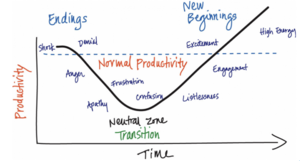
All behaviour is connected (no behaviour is isolated).
All behaviour is created jointly (and is in fact circular).
You cannot not behave.
All behaviour provokes feedback.
A change in one part of a system results in a change in another part.
Instructions
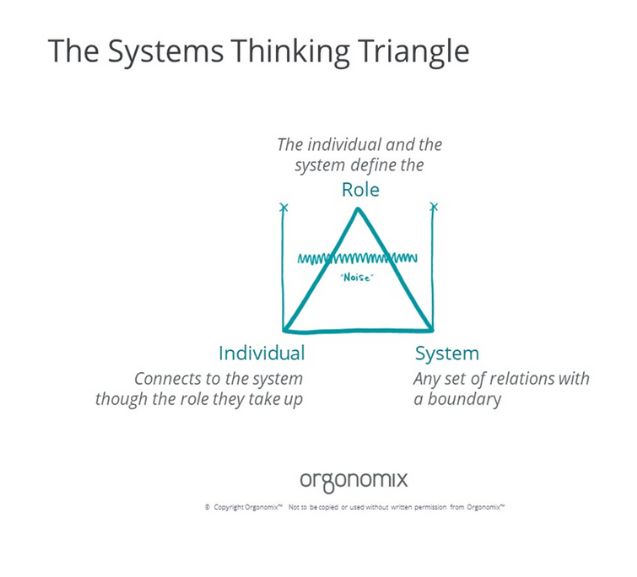
This model really builds off one of our ‘lenses of leadership’ from session 1 (Personal Vs Systemic). We think about people, teams and organisations too much from a personal perspective.
Using a systems lens can be very powerful, in particular thinking about role.
Understand how we take up a role on behalf of the system. Role can change instantly, as can the behaviours we exhibit due to our understanding of our role.
What reflections did you have as a result of the PCP? How have you been taking up your role? What’s working well?
Where is the noise with other roles? What action/support do you need?
Something to keep in mind in terms of how systems work is….
SLIDE XX: KEY SYSTEMS PRINCIPLES
All behaviour is connected (no behaviour is isolated).
All behaviour is created jointly (and is in fact circular).
You cannot not behave.
All behaviour provokes feedback.
A change in one part of a system results in a change in another part.
SLIDE XX: GREAT LET’S CHANGE
People say, that's great but change doesn't work. Kind of agree.
80% of change fails.
6% of change is felt by those at the front line.
We have talked in Session 1 a lot about the reasons why change fails so readily, and there are other reasons for it also...
SLIDE XX: CHANGE MODELS
Because we see change in this way, we need to go through all this pain and anger.
But this doesn't represent reality.
Change doesn't work this way because systems don't work this way.
We're not all in the 'endings' phase or the 'neutral' zone. We're all in different places and sometimes more than one place at the same time.
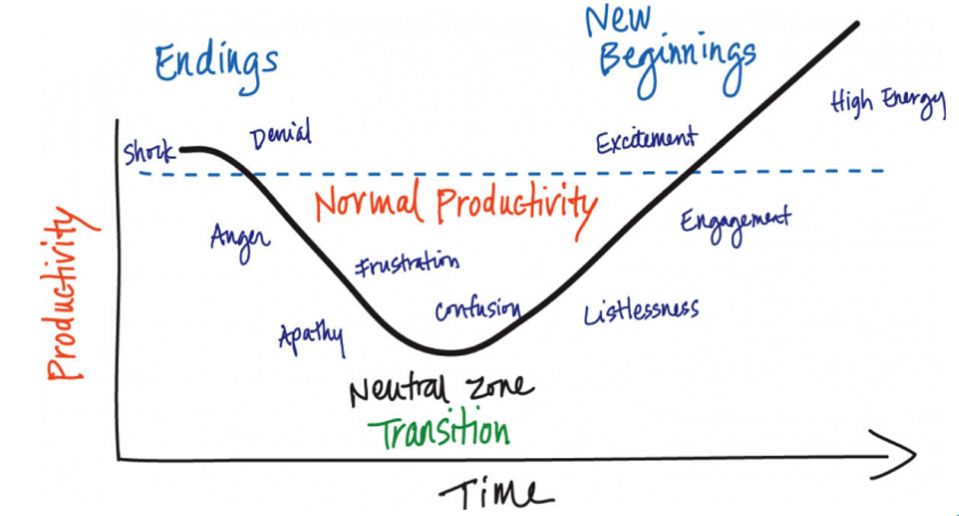
We may be in different places across the same team and particularly across the organisation.
We're a vibrant ecology of teams and organisations and people who have different needs.
Many change models, frameworks and advise is based on a misunderstanding of systems.
SLIDE XX: DEFINITION ADAPTIVE LEADERSHIP (reminder as have already covered it)
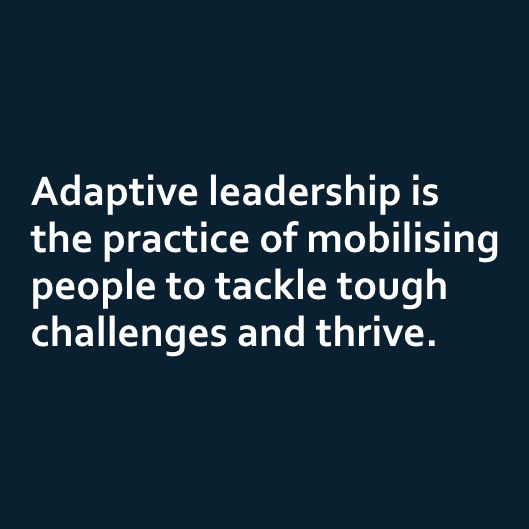
So if we think about this definition, what does it mean for change?
Mobilising people is the key word and remember everything we have talked about is really about that – e.g.
Understanding the difference b/w adaptive and technical work;
The non-linear nature of complex change;
Understanding leadership and the role of authority (direction, protection and order);
Better understanding diagnosis as being iterative in that in order to understand a complex adaptive system we need to interact with the system in order to learn (remember Observation – Interpretation – Intervention); and
PZD – we need to be able to turn the temperature up and down to create productive movement.
SLIDE XX: WE NEED TO CHANGE HOW WE CHANGE

So if we are committed to changing how we change and taking in to account the principles of above, we are going to share a model adapted from lean by Aaron Dignan (Brave New Work) who we saw in Module 3/Session 2 when we were talking about empowerment and creating Evolutionary organisations and in this module (session 1) around Complicated Vs Complex and being People Positive and Complexity Conscious.
SLIDES XX: CONTINUOUS PARTICIPATORY CHANGE
We can shoot for the big transformation approach, but unless we mobilise people at the local level it will all be a waste of time.
We're not going to a big org. chart review/re-org which probably won't work and we'll change in a few years anyway.
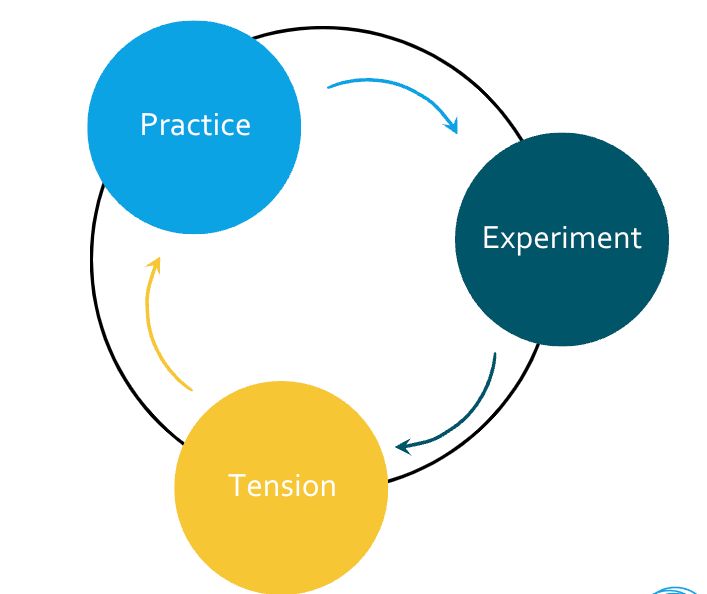
Tension: What's holding us back from doing our best work?
Practice: What alternative practices could we consider either inside or outside the organisation?
Experiment: What is the safe to try / safe to fail experiment? How do we do a radical thing on a non-radical scale so we can learn something powerful?
It either worked or didn't work?
Over time, it shifts change across the system.
SLIDE XX: HOW HIGH JUMP USED TO BE DONE
NB: This is an optional section and add if you think it adds value. It demonstrates how much we can be constrained by new ideas/thinking that challenge our own, which is particularly relevant where we are immersed in an organisational system.
This is how high jump used to be done for many, many years and for a very good reason because there was just dirt on the other side. If you fell on anything but your feet, you would be injured. It's called the straddle technique, there's also the scissor and various others.
Mid 60's the rules changed and suddenly there was a soft pad on the other side of the bar.
SLIDE XX: DICK FOSBURY
You may know the story of Dick Fosbury, who at just twenty-one years of age won the Olympic gold medal for the high jump by going over the bar backward and headfirst. His unorthodox technique, known as the “Fosbury Flop,” would change the sport forever. No world record holder since 1978 has used anything but the flop.
What you might not remember, though, is how his competition initially responded. By the time of the Olympics, his teammates in Oregon had been attempting Fosbury’s move for two years with no success. Even after his victory, the general sentiment was that this bizarre method worked, but only for Fosbury. It would never work for them.

When we share stories of Evolutionary Organisations with leaders struggling to unlock the potential in their teams, we hear “That works for Buurtzorg, but it will never work for us.
Must be a European thing.” “Netflix is a technology company. Of course they can do that.” Our regulators would never let us work that way.” Why do we reject innovative approaches when they are clearly better?
Behavioural economists have a name for this: the status quo bias. Think of this as our tendency to like things to stay the way they are. For example, imagine you’ve inherited a large sum of money and have to decide how to invest it. Here’s the twist: It’s already invested in a specific portfolio of stocks and bonds. Will you make a change? Studies show you probably won’t. We may like to think we’re making rational choices all the time, but the fact is we’re biased. We prefer to stick with what we’ve got.
We’re going to change tack considerably now, from a big picture change approach and bring back to the essence of leadership – and that is, who we are as people.
Attachments
- Screenshot 2024-06-29 at 3.36.02 pm.png
- Screenshot 2024-06-29 at 3.34.41 pm.png
- Screenshot 2024-06-29 at 3.33.35 pm.png
- Screenshot 2024-06-29 at 3.31.41 pm.png
- Screenshot 2024-06-29 at 3.30.13 pm.png
- Screenshot 2024-06-29 at 3.25.32 pm.png